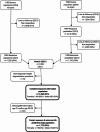Weight stigma in adolescents: sex differences, prevalence, emotional impact, and associations with BMI increases - a retrospective cohort study
- PMID: 40770711
- PMCID: PMC12326651
- DOI: 10.1186/s12889-025-23702-3
Weight stigma in adolescents: sex differences, prevalence, emotional impact, and associations with BMI increases - a retrospective cohort study
Abstract
Background: Weight stigma is an important public health concern due to its association with increased stress and adverse health outcomes, including poor metabolic health and weight gain. This study aimed to investigate the frequency and emotional impact of perceived weight stigma (PWS) during adolescence and its association with weight changes into young adulthood, with a focus on sex differences. We hypothesised that a high frequency of PWS during adolescence correlates with an increased emotional impact of PWS, that there are variations in PWS between sexes, and that PWS is associated with increased weight gain for both sexes.
Methods: A total of 2,466 young adults from Denmark were recruited for this cohort study. Participants recalled PWS from ages 15-20 via self-reported questionnaires at the ages 32/38. Self-reported weight and height were collected at age 21 and again at 32/38, allowing for calculation of BMI changes during follow-up (n = 1,772). For analysis, weight change was operationalised as a binary outcome: large BMI increases (above the 80th percentile) vs. all other. Logistic regression was used to examine the sex-specific frequency and emotional impact of PWS alongside BMI increases.
Results: Females reported significantly higher frequencies of PWS than males (0.5; 95% CI [0.27, 0.73]; p < 0.001). While females generally experienced higher emotional impact, males who reported high levels of emotional impact from stigma exhibited comparable risks of large BMI increases (aOR: females: 2.9; [1.9; 4.3], males: 2.4 [1.4; 4.3]). Contrary to our hypothesis, only modest correlations were found between the frequency of PWS and emotional impact (r = 0.31-0.61).
Conclusions: The study confirms that weight stigma during adolescence is associated with significant weight increases in young adulthood in both sexes. Although females report more frequent and emotionally impactful experiences, males showed similar adverse BMI increases. These findings underscore the importance of considering sex-specific patterns in future research on long-term consequences of weight stigma.
Keywords: Adolescence; Emotional impact; Sex differences; Weight change; Weight stigma.
© 2025. The Author(s).
Conflict of interest statement
Declarations. Ethics approval and consent to participate: The study was approved by the Central Denmark Region Health Research Ethics Committees with reference number 1-10-72-257-20 and the Danish Data Protection Agency (2017 − 899/ https://doi.org/10.0101/2015-57-000 ). All data collection waves have been conducted in accordance with the Declaration of Helsinki. According to Danish Law (Act on Research Ethics Review of Health Research Projects), available at www.nvk.dk/english/act-on-research , written consent was not required for this study as it relied solely on questionnaire and register data. Consent for publication: Not applicable. Competing interests: Jens M Bruun has been part of speaker’s bureaus and/or received research grants from Boehringer Ingelheim, Eli Lilly, MSD/Merck, and Novo Nordisk. The remaining authors of this manuscript declare that they have no conflicting interest to disclose. We confirm that this research was conducted objectively and impartially, and no financial or non-financial interests have influenced the design, execution, or reporting of this study. This work is solely driven by the pursuit of scientific knowledge and the advancement of our field.The remaining authors declare no competing interests.
Figures



Similar articles
-
Sertindole for schizophrenia.Cochrane Database Syst Rev. 2005 Jul 20;2005(3):CD001715. doi: 10.1002/14651858.CD001715.pub2. Cochrane Database Syst Rev. 2005. PMID: 16034864 Free PMC article.
-
An Examination of Perceived Stress and Emotion Regulation Challenges as Mediators of Associations Between Camouflaging and Internalizing Symptomatology.Autism Adulthood. 2024 Sep 16;6(3):345-361. doi: 10.1089/aut.2022.0121. eCollection 2024 Sep. Autism Adulthood. 2024. PMID: 39371362
-
Systemic pharmacological treatments for chronic plaque psoriasis: a network meta-analysis.Cochrane Database Syst Rev. 2021 Apr 19;4(4):CD011535. doi: 10.1002/14651858.CD011535.pub4. Cochrane Database Syst Rev. 2021. Update in: Cochrane Database Syst Rev. 2022 May 23;5:CD011535. doi: 10.1002/14651858.CD011535.pub5. PMID: 33871055 Free PMC article. Updated.
-
Braces for idiopathic scoliosis in adolescents.Cochrane Database Syst Rev. 2015 Jun 18;2015(6):CD006850. doi: 10.1002/14651858.CD006850.pub3. Cochrane Database Syst Rev. 2015. PMID: 26086959 Free PMC article.
-
A New Measure of Quantified Social Health Is Associated With Levels of Discomfort, Capability, and Mental and General Health Among Patients Seeking Musculoskeletal Specialty Care.Clin Orthop Relat Res. 2025 Apr 1;483(4):647-663. doi: 10.1097/CORR.0000000000003394. Epub 2025 Feb 5. Clin Orthop Relat Res. 2025. PMID: 39915110
References
-
- Puhl RM, Heuer CA. The stigma of obesity: A review and update. Obes (Silver Spring). 2009;17(5):941–64. - PubMed
-
- Pont SJ, Puhl R, Cook SR, Slusser W. Stigma experienced by children and adolescents with obesity. Pediatrics. 2017;140(6):e20173034. - PubMed
-
- Link BG, Phelan JC. Conceptualizing stigma. Ann Rev Sociol. 2001;27(27, 2001):363–85.
-
- Wu YK, Berry DC. Impact of weight stigma on physiological and psychological health outcomes for overweight and obese adults: A systematic review. J Adv Nurs. 2018;74(5):1030–42. - PubMed
-
- Puhl R, Schwartz M, Brownell K. Impact of perceived consensus on stereotypes about obese people: A new approach for reducing Bias. Health Psychology: Official J Div Health Psychol Am Psychol Association. 2005;24:517–25. - PubMed
MeSH terms
LinkOut - more resources
Full Text Sources

